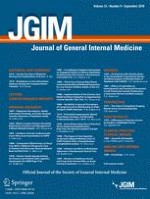Erschienen in:

07.05.2018 | Original Research
A Coaching by Telephone Intervention on Engaging Patients to Address Modifiable Cardiovascular Risk Factors: a Randomized Controlled Trial
verfasst von:
Eugene Z. Oddone, MD, MHSc, Jennifer M. Gierisch, PhD, MPH, Linda L. Sanders, MPH, Angela Fagerlin, PhD, Jordan Sparks, MPH, Felicia McCant, MSSW, Carrie May, MPH, Maren K. Olsen, PhD, Laura J. Damschroder, MPH, MS
Erschienen in:
Journal of General Internal Medicine
|
Ausgabe 9/2018
Einloggen, um Zugang zu erhalten
Abstract
Background
A large proportion of deaths and chronic illnesses can be attributed to three modifiable risk factors: tobacco use, overweight/obesity, and physical inactivity.
Objective
To test whether telephone-based health coaching after completion of a comprehensive health risk assessment (HRA) increases patient activation and enrollment in a prevention program compared to HRA completion alone.
Design
Two-arm randomized trial at three sites.
Setting
Primary care clinics at Veterans Affairs facilities.
Participants
Four hundred seventeen veterans with at least one modifiable risk factor (BMI ≥ 30, < 150 min of at least moderate physically activity per week, or current smoker).
Intervention
Participants completed an online HRA. Intervention participants received two telephone-delivered health coaching calls at 1 and 4 weeks to collaboratively set goals to enroll in, and attend structured prevention programs designed to reduce modifiable risk factors.
Measurements
Primary outcome was enrollment in a structured prevention program by 6 months. Secondary outcomes were Patient Activation Measure (PAM) and Framingham Risk Score (FRS).
Results
Most participants were male (85%), white (50%), with a mean age of 56. Participants were eligible, because their BMI was ≥ 30 (80%), they were physically inactive (50%), and/or they were current smokers (39%). When compared to HLA only at 6 months, health coaching intervention participants reported higher rates of enrollment in a prevention program, 51 vs 29% (OR = 2.5; 95% CI: 1.7, 3.9; p < 0.0001), higher rates of program participation, 40 vs 23% (OR = 2.3; 95% CI: 1.5, 3.6; p = 0.0004), and greater improvement in PAM scores, mean difference 2.5 (95% CI: 0.2, 4.7; p = 0.03), but no change in FRS scores, mean difference 0.7 (95% CI − 0.7, 2.2; p = 0.33).
Conclusions
Brief telephone health coaching after completing an online HRA increased patient activation and increased enrollment in structured prevention programs to improve health behaviors.
ClinicalTrials.gov Identifier
NCT01828567











